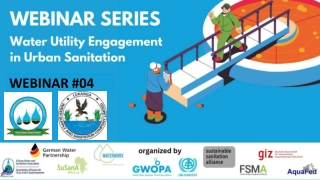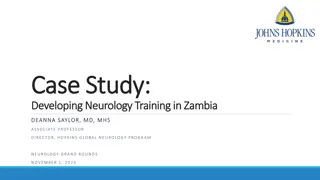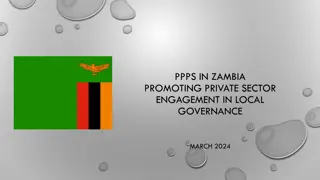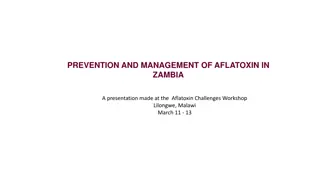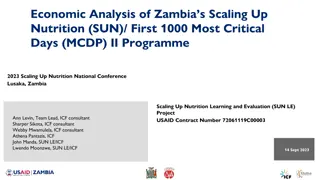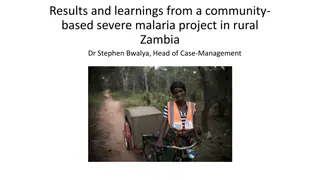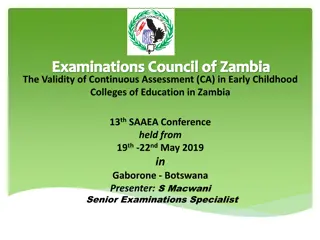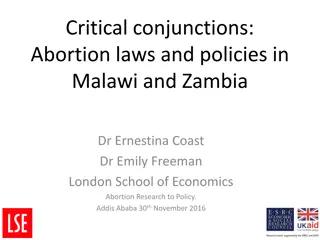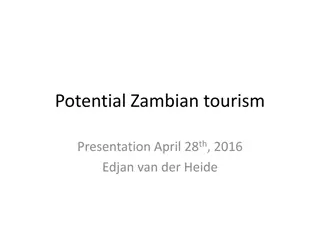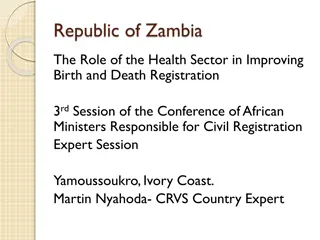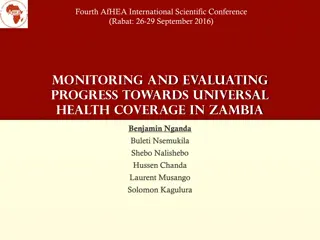Strengthening Environmental Statistics in Zambia: Capacity Assessment Results
Presentation of the results from a survey conducted in Zambia to identify environmental statistics in the National Statistical System. The survey focused on key capacity areas applying the CD4.0 approach, including institutional setting, legal framework, funds, infrastructure, data coordination, statistical production, alternative data sources, communication strategy, and human resource management. Respondents included various organizations related to environment and statistics. Findings revealed challenges such as resource constraints, lack of trained personnel, and inadequate data literacy. Recommendations were made to address these gaps and enhance environmental statistical activities in Zambia.
Download Presentation

Please find below an Image/Link to download the presentation.
The content on the website is provided AS IS for your information and personal use only. It may not be sold, licensed, or shared on other websites without obtaining consent from the author.If you encounter any issues during the download, it is possible that the publisher has removed the file from their server.
You are allowed to download the files provided on this website for personal or commercial use, subject to the condition that they are used lawfully. All files are the property of their respective owners.
The content on the website is provided AS IS for your information and personal use only. It may not be sold, licensed, or shared on other websites without obtaining consent from the author.
E N D
Presentation Transcript
Operationalising CD4.0 in Zambia: Strengthening environmental statistics in the National Statistical System (NSS). Presentation of the Results of the Capacity Presentation of the Results of the Capacity Assessment survey Assessment survey
OUTLINE OF PRESENTATION Overview over the survey Key capacity areas applying the CD4.0 approach Institutional setting and organisational design Legal framework Funds infrastructure Data ecosystem coordination Statistical production process Alternative data sources Communicating strategy and advocacy Human resource management Incentives Conclusions
Objective of the survey Identify environmental statistics in the National Statistical System (NSS) of Zambia. To do this, a questionnaire which focused on the legal framework, coordination mechanisms, statistical planning, communication and dissemination was sent to stakeholders. capacity statistics gaps related to funding infrastructure,
Respondents of the survey An online questionnaire was sent to the following organisations; Lands and Natural Resources National Water Supply and Sanitation Council Lusaka City Council Energy Water Resources Management Authority [WARMA] Ministry of Water Development Sanitation and Environmental Protection Tourism and Arts/Department of National Parks and Wildlife Zambia Statistics Agency Ministry of Fisheries and Livestock Ministry of Agriculture Office of the Vice President - Disaster Management and Mitigation Unit (DMMU) Ministry of Fisheries and Livestock National Development Planning Ministry of Lands and Natural Resources ZAMBIA METEOROLOGICAL DEPARTMENT Mines and Minerals Development Ministry of National Development Planning Indaba Agricultural Policy Research Institute (IAPRI)
Key capacity areas Key capacity areas applying the CD4.0 approach applying the CD4.0 approach Target/Level Target/Level Individual Individual Organisational Organisational System System Most organizations lack resources to carry out environmental statistical activities. Lack of statistical production processes Lack of communication strategy The is existence of legislation though most stakeholders are not aware. Most of the Staff in the organizations are not trained in environment statistics Resources Resources In almost all the organizations, the is a shortage of trained personnel in environment statistics Lack of data literacy due to lack of training. Skills and Skills and Knowledge Knowledge Lack of data ecosystem coordination Lack of coordination among stakeholders producing environment statistics. Lack of advocacy strategy in almost all organizations. Most of the Staff in the organizations are not trained in environment statistics Very few people in management are trained in environment statistics Management Management Most individuals working on environment statistics are not motivated because most of the time they receive no funding There is lack of incentives among workers in most organizations due a lack of financial rewards Lack of advancement opportunities for employees in most organizations. Incentives Incentives
Institutional setting and organizational design Q13. What are the main tasks that your organization has performed in the domain of environment statistics for the past 3 years? 83.3% of the organizations are involved in data collection. A good number of organizations (55.6%) are involved in conducting methodological work, compiling statistics and maintaining statistical databases and answering requests for data and statistics from users. Very few organizations (11.1%) are involved in technical coordination (adherence to international standards, manuals, classifications) and disseminating statistics via publications and/or website 11.1 Environmental regulator Environmental regulator 16.7 Conducting statistics training Conducting statistics training 16.7 Aswering requests for data Aswering requests for data 55.6 Disseminating statistics Disseminating statistics 61.1 Harmonizing statistics Harmonizing statistics 11.1 Compiling statistics and Compiling statistics and 55.6 Conducting methodological Conducting methodological 83.3 Collecting data Collecting data 11.1 Technical coordination Technical coordination 27.8 Institutional coordination Institutional coordination
Institutional setting and organisational design Main tasks performed in Main tasks performed in the domain of environment statistics for the past 3 years the domain of environment statistics for the past 3 years Institutional Institutional coordination coordination (e.g. (e.g. coordinating coordinating an inter an inter- - agency agency committee committee that serves as that serves as a venue for a venue for discussion on discussion on statistics statistics MWDSEP ZamStats MNDP MLNR MMD Conducting Conducting methodological methodological work (developing work (developing of indicators, of indicators, measurement measurement issues, data issues, data collection collection methods) methods) Technical Technical coordination coordination (adherence to (adherence to international international standards, standards, manuals, manuals, classifications) classifications) Conducting Conducting statistics statistics training for training for data users data users (e.g. (e.g. policymaker policymaker s, citizens) s, citizens) Compiling Compiling statistics and statistics and maintaining maintaining statistical statistical databases databases Harmonizing Harmonizing statistics based statistics based on on methodological methodological standards standards Disseminating Disseminating statistics via statistics via publications publications and/or a and/or a website website Answering Answering requests for requests for data and data and statistics from statistics from users users Environmental Environmental regulator regulator Collecting data Collecting data Other Other T & A/DNPW MoLNR MLNR NWASSCO MOE WARMA MWDSEP T & A/DNPW ZAMSTATS MoFL MoA MoNDP MLNR MoMMD IAPRI NWASSCO LCC MWDSEP T & A/DNPW ZamStats MOA MLNR MMMD MNDP IAPRI MLNR NWASSCO WARMA MWDSEP T & A/DNPW ZAMSTATASs MoFL MoA MNDP IAPRI WARMA MoA NWASSCO WARMA MWDSEP T & A/DNPW MWDSEP ZAMSTATS MoFL MoA MNDP IAPRI MLNR MMMD NWASSCO MLNR MOE MFL MMMD Iapri LCC MWDSEP T & A DNPW DMMU T & A/DNPW MFL MOA ZMD MNDP
Funds Infrastructure: A majority of organizations have a strategic Funds Infrastructure: A majority of organizations have a strategic fundraising plan fundraising plan Q5. Does your organizations have a Strategic Plans to Secure Funding for Q5. Does your organizations have a Strategic Plans to Secure Funding for Environment Statistical activities? Environment Statistical activities? This can include budgeting, identifying possible This can include budgeting, identifying possible resources and funders, and the required actions and activities, such as negotiating resources and funders, and the required actions and activities, such as negotiating with national with national No strategic plan 41.2 With Strategic Plan 58.8
Funds infrastructure: A lack of a dedicated ENV budget Funds infrastructure: A lack of a dedicated ENV budget 66.7% of the organizations do not have a dedicated budget as part 66.7% of the organizations do not have a dedicated budget as part of the national government budget specifically for environment of the national government budget specifically for environment statistics statistics Ad Ad- -hoc funding is available for 43% of the respondents hoc funding is available for 43% of the respondents Q9: Is there a dedicated budget, as part of the national government Q9: Is there a dedicated budget, as part of the national government budget, specifically for environment statistics? budget, specifically for environment statistics? 68.75 31.25 Yes No
Funds infrastructure: A lack of coordination of funds appears to Funds infrastructure: A lack of coordination of funds appears to play an important role play an important role Q5. Does your organizations have a Strategic Plans to Secure Funding for Environment Statistical activities? Q5. Does your organizations have a Strategic Plans to Secure Funding for Environment Statistical activities? This can include budgeting, identifying possible resources and funders, and the required actions and activities, such as negotiating with budgeting, identifying possible resources and funders, and the required actions and activities, such as negotiating with national authorities and/or external partners, foundations or companies. national authorities and/or external partners, foundations or companies. Organizations Organizations without without Strategic Plans Strategic Plans 2020 - 2030 WARMA Not sure NWASSCO 2016 - 2020ZAMSTATS Lack of financial and technical support MOE 2018 - 2030MFL The Statistics Strategy is not there in the Ministry It is not really in the work of the Ministry of Agriculture to handle environmental statistics. Environmental statistics are only collected when and during the undertaking of various projects and programs related to Agricultural production and development. T & A/DNPW Not stated DMMU Because our mandate is purely Disaster Management We are a national coordinating ministry not the implementing ministry although we have a national authorizing office that funds climate change projects MNDP - Planning Dept. 2019 - 2021 MLNR Not stated MMMD 2018 - ? IAPRI 2017 - 2022 This can include Organizations with Organizations with Strategic plan Strategic plan Period of Period of the plan the plan Reason why Strategic Plan does not exist Reason why Strategic Plan does not exist Department of Forestry 2018 - 2021 MWDSEP MOA 2020 Department of Fisheries MNDP - M & E
Funds infrastructure Funds infrastructure Funding commitments per organisation Funding commitments per organisation - - Highest funding committed to MWDSEP Lowest funding to MLNR Q10. Please indicate the funds committed against disbursement in Kwacha for the 2019 budget. Q10. Please indicate the funds committed against disbursement in Kwacha for the 2019 budget. Organizations with Organizations with dedicated budget dedicated budget Funds committed Funds committed Funds disbursed Funds disbursed Percent disbursed Percent disbursed 1,200,000 Department of Forestry - - 32,163,296 32,163,296 MWDSEP 100.0 4,600,000 4,600,000 MOA 100.0 659,614 Department of Fisheries 10,000 1.5 519,476 MLNR 200,000 38.5 39,142,386 Total 36,973,296 94.5
Funds infrastructure Funds infrastructure - - COVID 19 has reduced domestic and COVID 19 has reduced domestic and external funding in a third of the cases external funding in a third of the cases Q12 & 15. In what way has the COVID 19 pandemic affected funding to environment statistics activities? 33.3 35 31.3 30 26.7 26.7 25 25 25 18.8 20 13.3 15 10 5 0 Reduced funding Delayed funding No funding No effect Domestic funding External funding
Funds infrastructure Funds infrastructure Q13. Please indicate international development cooperation providers currently supporting your Q13. Please indicate international development cooperation providers currently supporting your organization organization on on environment statistics. environment statistics. Development Cooperation Partner Development Cooperation Partner Partner 2 Partner 2 GEF Bill & Melinda Gates Foundation Global Environment Facility Zambian Carnivore Programme Organization Organization Partner 3 Partner 3 Partner 4 Partner 4 Partner 1 Partner 1 Dept. of Forestry FAO UNEP NWASSCO MWDSEP GIZ WB T & A/DNPW Dept. of Fisheries MNDP - Planning Dept. African Development Bank GLobal Environment Facility (GEF)/UNDP MMMD ZMREP ZAMSTATS OECD Frankfurt Zoological Society FAO KfW World Bank DFID - UK MLNR Commonwealth Green Climate Fund European Union STATS SWEDEN PARIS21
Data ecosystem coordination Data ecosystem coordination Organisations cooperate inside the NSS for SDG reporting. Q19. Does your organization collaborate with the Q19. Does your organization collaborate with the following entities on environment statistics? following entities on environment statistics? 62.5 Entities at sub-national level via technical working groups 37.5 87.5 Mimistry of National Development Planning for SDG reporting 12.5 Yes No
Statistical production process Statistical production process About 80% of the organisations lack estimation software Q51. Has your organization moved away from paper-based data collection to CAPI in the domain of environmental statistics? 57.1 42.9 Yes No
Alternative data sources Most organisations use administrative data sources in the domain of ENV statistics. Q24. What alternative data sources have been used to produce proxy Q24. What alternative data sources have been used to produce proxy indicators in the domain of environment statistics in the past 3 years? indicators in the domain of environment statistics in the past 3 years? 73.3 40.0 6.7 Geospartial Information Administrative data Other
Alternative data sources Alternative data sources TYPE OF DATA USED BY ORGANIZATION TYPE OF DATA USED BY ORGANIZATION ADMINISTRATIVE ADMINISTRATIVE GEOSPATIAL GEOSPATIAL OTHERS OTHERS FORESTRY FORESTRY NWASCO - WORKING GROUPS ENERGY WARMA MWDSEP DMMU DNPW MNDP ZAMSTATS MLNR LIVESTOCK IAPRI MOA DMMU FISHERIES MNDP
Communicating strategy and advocacy Communicating strategy and advocacy 73% of the organizations do not have a communication strategy/policy that includes a focus on environment statistics. Organizations with communication strategy Ministry of Land and Natural Resources (Data sharing guidelines/policy) National Water Supply and Sanitation Council (Annual sector report) Ministry of Energy (Energy sector strategy plan 2021 2025) Department of Fisheries Disaster Management and Mitigation Unit Q27. Does your organization have a communication policy/strategy that includes a focus on environmental statistics? 73.33 26.67 Yes No
Communicating strategy and advocacy Communicating strategy and advocacy Dissemination of SDG indicators is not well developed and could be further improved. The only exception is the Ministry of National Development Planning. Q30. If the organization has an active website, is there a dedicated SDG section with environmental indicators? (%Share) 6.67 No, 93.33
Communicating strategy and advocacy Communicating strategy and advocacy Social media is largely untapped as important channel for data dissemination and communication. Q31. Do you use social media to promote the environmental statistical products published? 60.0 40.0 20.0 6.7 - Twitter LinkedIn Facebook Do not use Other
Human resource management About 93% of the organizations do not have an HR strategy/policy in place with focus on environmental statistics skills Q43. Does your orgainization have an HR strategy/policy in Q43. Does your orgainization have an HR strategy/policy in place with focus on environmental statististics skills? place with focus on environmental statististics skills? 92.9 7.1 Yes No
Human resource management Yet, technical training covers skills and knowledge relevant to ENV statistics. Q44. Does technical training of data producers at your organization Q44. Does technical training of data producers at your organization cover skills and knowledge relevant to environmental statistics? cover skills and knowledge relevant to environmental statistics? 57.1 42.9 Yes No
Incentives About 93% of organizations have no rewards granted to employees in return for their outstanding work to motivate them to deliver their tasks in the domain of environment statistics Q45. Are there any rewards granted to employees in return for Q45. Are there any rewards granted to employees in return for their outstanding work to motivate them to deliver their tasks their outstanding work to motivate them to deliver their tasks in the domain of environmental statistics? in the domain of environmental statistics? 92.9 7.1 Yes No
Conclusion and main take aways Benefits of the CD4.0 approach CD4.0 approach guides NSSs alongside other relevant resources to better respond to the needs of their stakeholders, and thus support appropriate decisions about the 2020 Agenda as well as regional and national policies. It takes into account gaps in statistical capacity It takes into account challenges posed by the new data ecosystem and the 2020 Agenda https://paris21.org/sites/default/files/inline- files/CD4.0-Framework_final.pdf
Conclusion and main take aways Most important findings Low awareness of the legal framework Many organizations lack strategy fundraising plans Lack of a dedicated budget for environment statistics Lack of coordination of available funds COVID 19 has reduced funding in a third of cases The is cooperation inside the NSS for SDG reporting Most organisations do not have estimation software A lot of organizations use administrative data sources 73% of organizations do not have a communication strategy/policy that includes a focus on environment statistics Dissemination of SDG indicators is not well developed and be improved Use of social media is largely untapped as important channel for data dissemination and communication About 93% of organizations do not have a HR strategy/policy with focus on environmental statistics skills. Most organizations do not have incentives for their employees.
END OF PRESENTATION THANK YOU VERY MUCH FOR LISTENING
Next steps To conduct a user satisfaction survey This will help us to know whether data collected is used and who uses it and for what purpose. Assess user demand related to environmental statistics in Zambia Understanding the needs of users will help identify shortfalls in the use of environmental statistics The data from the survey will help us in defining user groups of environment statistics




